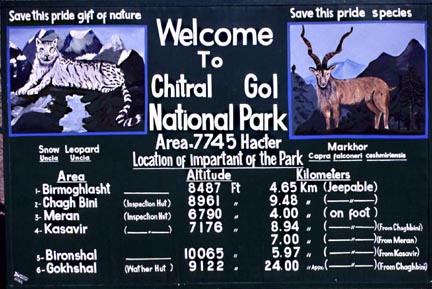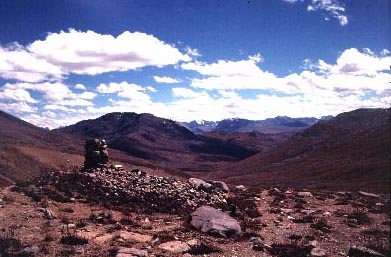Appendix H - Protected Areas
Pakistan currently recognises just three categories of protected areas: national parks, wildlife sanctuaries, and game reserves. These now outdated categories and the equally outdated legislation behind them severely restrict how Pakistan manages its unique wilderness resources. Current United Nations sanctioned categories number six, with a wide range of management options.
Almost all of Pakistan's protected areas in the Karakoram and Hindukush were once the property of local princes. When the princely states were absorbed into Pakistan, the government assumed ownership of these areas. Local people, who had traditionally used the areas for pasturing and wood gathering saw themselves as the inheritors of the high mountain valleys and grasslands. The resulting disputes are still with the courts.
In addition, these mountain areas have now also become the object of desire of a number of competing interests - resort hotels, polo tournaments, adventure tourism, big game hunting, and the military. Pakistan's understaffed, underequipped, and undertrained wildlife officers are unable to handle the growing complexity of management. With the government as owner, and others as users, no one has sufficient control over resources, and effective management seems impossible. Whether the government can revise legislation and resolve park conflicts resulting from multiple users remains to be seen.
H.1.0. National Parks
There are three officially gazetted national parks in the Karakoram and Hindukush: Chitral Gol, Khunjerab, and Central Karakoram. Two other parks, Shandur-Hundrup and Deosai Wilderness, were declared national parks by the Chief Commissioner of the Northern Areas in 1993. They are currently under review for the official gazetting process by the federal government. Tourists who visit these two new parks will find no indication of their park status. So far, they are parks on paper only. National parks are administered by the government Forestry Division. Contact the District Forestry Officer (DFO) for Wildlife in each area for more information about each park.
The National Council for the Conservation of Wildlife (NCCW) is part of the Ministry of Food, Agriculture & Cooperatives of the Government of Pakistan. It has the major responsibility for development of national parks in the Karakoram and Hindukush. Their office is in Islamabad.
H.1.1. Chitral Gol National Park
This 7750 hectare former hunting preserve of the ex-Mehtar of Chitral has one of the few remaining viable populations of markhor, currently several hundred in number. To raise funds for park management, two hunting permits per year used to be sold for US$10,000 each. Now, because the markhor is an endangered species and import of markhor trophy heads is forbidden by most countries, this hunting has ceased. Chitral Gol's ownership is tied up in a three-way dispute between the ex-Mehtar, who claims it is still his private property, the government and local people. The case has been in litigation for more than 20 years. Hopefully, these three parties will decide to work together to manage and conserve this beautiful ecosystem for future generations.

H.1.2. Khunjerab National Park
This 2269 sq km area is in the Gojal region of northern Hunza. It lies on either side of the KKH from Dih to the China border at the Khunjerab Pass. Most of Shimshal's Pamir and Ghujerab regions are also included, but currently, only the area along the KKH is being actively managed.
The famous wildlife biologist George Schaller recommended the establishment of this park in 1975 to the then Prime Minister, Zulfikar Ali Bhutto, who declared it done. Unfortunately, almost nothing actually was done beyond the declaration. Marco Polo sheep, a magnificent species once abundant in the Khunjerab Pass region, were almost wiped out. They now appear to be recovering thanks to efforts by WWF to develop sound management practices that respect the rights of local communities and involve them in decision making. Efforts in this park may point the way ahead for parks in the rest of Pakistan. The Directorate of Khunjerab National Park (DKNP) is responsible for management of the Khunjerab National Park, and is staffed by officials from the Forestry Department. The local staff is largely under-equipped and untrained. The DKNP operates more as a bureaucracy with administrative headquarters in Gilgit. Wildlife protection is the responsibility of villagers living near the park.

H.1.3. Central Karakoram National Park
Established in 1993 in response to growing environmental pressure on Baltistan's once pristine Baltoro Glacier, this park also includes the Biafo and Hispar glaciers and their tributaries. The crown jewel, of course, is K2 (8611 metres). On the Baltoro Glacier, the accumulation of military hardware and debris from the long-simmering conflict with India remains a problem. Management plans have yet to be developed and time will tell if the park can avoid repeating the same problems that have plagued other parks.

H.1.4. Shandur-Hundrup National Park
This park includes two separate areas in the Northern Areas' Ghizar district; the 996 sq km Hundrup River valley up to the Dadarelli An, and the 644 square km Shandur Pass area. The Hundrup River is a world-class trout stream and the Shandur Pass is the site of an annual polo tournament extravaganza. The area was declared a park in an attempt to control the merrymakers at the polo tournament, who were not inclined to clean up their mess. Now, tour operators are cleaning up after the tournament, but garbage still fills ravines in the high meadows beside Shandur Lake.
H.1.5. Deosai Plateau Wilderness Park
The Deosai Plateau is a 3464 sq km high-altitude plain bordering on Indian Kashmir. Uninhabited and little-used, the area has the largest brown bear population in Pakistan, numerous marmots, and clear streams with unusual snow trout.

H.2.0. Wildlife Sanctuaries
Wildlife sanctuaries are all remote former hunting grounds of local rulers. For each sanctuary there is at least one designated game watcher. There is no visible indication of the sanctuary status of these areas. In theory, hunting is banned. Wildlife sanctuaries include:
- Agram-Besti Wildlife Sanctuary covers 30,000 hectares in the high valleys of Agram and Besti in the Lutkho district of Chitral.
- Naltar Wildlife Sanctuary covers 273 sq km of the Naltar Valley to its juncture with the Hunza River, and is contiguous with the Pakora and Sherqila Game Reserves.
- Kargah Wildlife Sanctuary covers 445 sq km of the Kargah Valley just five km north-west of Gilgit. This sanctuary is also the sight of over a half dozen dam and hydroelectric projects. The road there is good, and it is mostly used as a cool picnic spot during hot summer days in Gilgit.
- Astor Wildlife Sanctuary covers 416 sq km on the north side of the Astor Valley from the junction with the Indus River to the confluence with the Parashing Gah. It is contiguous with the Baltistan Wildlife Sanctuary.
- Baltistan Wildlife Sanctuary covers 415 sq km in Baltistan, contiguous with the Astor Wildlife Sanctuary to its south and east. It lies south of the Indus River, between Rondu and Shengus villages.
- Satpara Wildlife Sanctuary lies 35 km south of Skardu in Baltistan. It includes Satpara Nala and lake, and borders the Deosai Plains.
H.3.0. Game Reserves
Game Reserves, too, were former hunting grounds, or shikar gah. Most of the game now is scarce and hard to find, but herds of ibex can be encountered when descending a pass. Villagers report snow leopard in almost every one of these reserves. Game Reserves include:
- Tooshi Game Reserve, along the paved road to Garam Chashma in Chitral's Lutkho district, covers 1000 hectares and is proposed to be reclassified as a wildlife sanctuary, as it has a large (about 160) and readily viewable markhor population. The markhor are best seen along the road at dusk. The jeep ride is just 20 minutes from Chitral town.
- Ghariet Gol Game Reserve covers 4800 hectares of the Ghariet Gol, east of the Chitral River in southern Chitral.
- Drosh Gol Game Reserve covers 2000 hectares of the small Drosh Gol, above Drosh village, east of the Chitral River.
- Chinar/Purit Gol Game Reserve, 6500 hectares, covers the Purit Gol, a southern tributary of the Shishi Gol close to Drosh.
- Golen Gol Game Reserve in Chitral, covering 50,000 hectares, is one of the most beautiful and extensive areas, with numerous side valleys. But, it is also one of the most vexed in terms of usage conflict. Still, with its fantastic variety of ecosystems, it is a trekkers delight.
- Chassi/Bahushtaro Game Reserve includes 37,000 hectares of the rugged territory of the Bahushtaro Gol and is contiguous with the Naz Bar Game Reserve.
- Naz Bar Nala Game Reserve covers 33,000 hectares of the upper Naz Bar in Yasin.
- Pakora Game Reserve includes 7500 hectares of the Pakora Valley in Ishkoman and is contiguous with the Naltar Wildlife Sanctuary.
- Sherqila Game Reserve, in Ghizar district 48 km west of Gilgit, covers 17,000 hectares of Sherqila Valley above Sherqila village.
- Dainyor Game Reserve is six km east of Gilgit and covers 44,000 hectares.
- Kilik/Mintaka Game Reserve lies along the border with China, east of the KKH and the Khunjerab National Park. It includes 65,000 hectares of important Marco Polo sheep habitat, and is closed to foreigners.
- Stak Nala Game Reserve covers 13,000 hectares north of the Indus River in Baltistan.
- Nar/Ghoro Game Reserve covers the 7000 hectare area of two small valleys that run north of the Indus River between the Shigar and Shyok rivers, east of Skardu.
